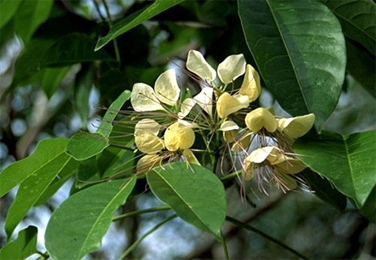Varuna (Crataeva nurvala)

Description of Plant
Crataeva nurvala is deciduous, medium sized tree which reaches height up to 50 feet. Leaves of varuna are trifoliate, about 8-12cm long, with oval or ovoid leaflets. Bark of the tree is smooth and brown in color while the branches are white tinged with purple and yellow patches. The flowers are greenish white, light yellowish or creamy colored and are fragrant. Bark contains horizontal wrinkles, smooth and gray in color. Diameter of fruits is 2.5cm, ovoid berries, resembles to lemon changes to red color after ripening. Seeds contain multiple seeds engulfed in fresh yellow pulp. Flowering season of herb is month of March and fruits appear in the month of June.
General Information
Three leaved caper, barun, baruna, crataeva, borun, holy garlic pear, scared lingam tree and triune all are synonyms of crataeva nurvala. In Ayurveda more than 3000 years bark of this herb is best used to treat kidney stones, urinary tract infections and prostate related disorders as well as benign prostatic hypertrophy. Bark is anti-inflammatory, antiseptic, laxative and carminative in nature. This herb is also good for heart it is used to clear the blockage of arteries. Both the bark and leaves are extensively used to prepare ayurvedic medications. Bark of the tree generates alcohol, lupeol, friedlin, disogenin and betulinic acid.
Main chemicals available in this herb are flavonoids, tannins, saponins, titerpenes, alkaloids, glucosilinates and plant sterols. Rind of varun fruits are used as mordant in dyeing. Leaves contain stachydrine, quercetin and isoquuercetin. Fruits are rich in cetyl alcohol, tricontanol and beta- sitosterol. Leaves of varuna are recommended during menstrual pain and bark is effective to cure convulsions and tympanitis.
It is very effective herb for treating renal conditions. It is used to increase appetite, stimulates digestion and very effective herbal treatment for flatulence and various abdominal disorders.
In Vedic literatures this herb is used as blood purifier. Bark of this herb is very effective for treating urinary tract infections. Acharya shushruta mentioned this herb as litholytic in nature and used it to cure different types of ashmari (calculi). According to acharya charak wood of varuna is used in nadi Swaden (for inducing sweating) and sootikagar (Postpartum ward).
Habitat
Varuna is basically native to India and Bangladesh, often grown in neighborhood of temples. Varuna is distributed throughout India, especially in the sub-alpine zones along streams and rivers. In India it grows almost in semiarid regions. It is found abundantly in Madhya Pradesh, Kerala, Bengal and Assam.
Classification
- Kingdom – Plantae
- Order – Brassicales
- Family – Capparaceae
Names
- English name – Three leaved caper, Holy garlic pear, Triune leaf tree, sacred lingam tree, Lengam tree
- Hindi name – Barna, Barun, Bila
- Kannada name – Adhiraaja, Bilpatri, Bitusi, Doddelanage, Hoddelengae
- Telugu name – Ulimiri chettu
- Marathi name – Bhatavarna, Hadavarna, Kawan, Kumla
- Tamil name – Maralingami
- Bengali name – Barun tiktoshak
- Burmese name – Kadat, Kadet, Katat
- Gujarati name – Varno, Vayavarno
- Konkani name – Nervol
- Malayalam name – kili, Niravila, Nirumaliyan
- Punjabi name – Barna, Barnahi
- Sinhala name – Lunuwarana
- Urdu name – Barna
- Oriya name – Barna
Ayurvedic Properties
| Hindi / Sanskrit | English | ||
| Rasa | Kashay, Tikta | Taste | Astringent, Bitter |
| Guna | Laghu, Ruksha | Physical Property | Light, Dry |
| Virya | Ushna | Potency | Hot |
| Vipaka | Katu | Metabolic Property (After Digestion) | Pungent |
Effects on Doshas
It balances kapha and vata dosha.
| Charak Samhita | Sushrut Samhita | Vagbhata | Vagbhata |
|
Tikta skanda – Herbs with bitter taste. |
Varunadi gana |
Varunadi gana |
Vatadi gana |
Ancient verse about Crataeva Nurvala

It states that varun, baran, setu, tiktashak and kumarak all are synonyms of crataeva nurvala. Varun is astringent, pungent, sweet and bitter in taste. It is light and rough in nature and this herb aggravates pitta dosha in body due to its hot potency. It is used to stimulate digestive fire and used to pacify kapha and vata dosha. It is used to treat urine retention, calculi, abdominal tumors and worm infestation.
Practical uses of Crataeva Nurvala
- Varuna is best litholytic herb and it has been used throughout ages to treat crystalluria and urolithiasis. This herb is also very beneficial for treating benign prostate hyperplasia.
- It is best herb that has ability to cure kidney stones, kidney disorders and other underlying symptoms associated with renal system. It helps to deactivate glycolate oxidase enzyme which decreases the extra production of oxalate. Oxalate is responsible for the formation of calculi, thus it helps to hinder the production of calcium salts.
- Varuna is very effective anti-inflammatory herb. It is used to reduce inflammation in rheumatic patient. It is also used to cure infected lymph nodes of neck, stiffness and joint pain.
- It is best herb to reduce painful urination caused by enlarged prostate. It helps in the strengthening of bladder muscles.
- It helps to remove extra body toxins especially urea and creatinine that are harmful for body functioning.
- It helps in boosting up body metabolism and helps liver to work properly. It helps to restore extra bilirubin levels and protect body against liver diseases. It is considered best herb for liver disorders and anorexia. It works as appetizer and helps in the movement of flatus and feces downwards and it removes the impacted stool and used to cure abdominal distention.
- It is also used for treating worm infestation in both adults and infants.
- Decoction of varuna bark is useful for treating gout, internal abscess and lymphadenopathy. Bark paste is applied externally for various skin diseases.
- In Ayurveda varun is used as natural blood purifier to maintain homeostasis. It is used in treating blood flow, fever, and breathing problems and used to eliminate extra waste out of body.
- It is also use to expel out extra phlegm and bile secretion from body. This herb is also good for obese persons because it scraps out extra fat out from body.
- Bark of this herb also possesses anti-diabetic properties. It helps to reduce extra secretion of insulin and reduces blood sugar levels.
- Decoction of bark is used to heal internal and deep seated suppurated inflammation.
- It is used to pacify both kapha and vata dosha.
Ayurvedic Products from Creatava Nurvala
Part used
- Bark
- Root bark
- Leaves
- Stem bark
Dosage
- Decoction: 50-100ml



